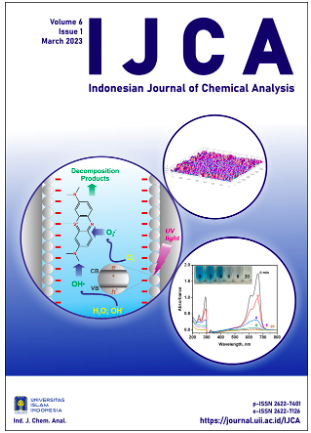Main Article Content
Abstract
Thin film of TiO2 modified Ni2+ cationic (Ni doped-TiO2) thin films were synthesized from titanium tetraisopropoxide (TTIP) and Ni(NO3)2.6H2O using the combined sol-gel and dip coating method followed by calcination at 500oC for an hour. This study aims to determine the concentration of Ni2+ and the optimum number of layers for application as self-cleaning. Frontier transform infrared (FTIR) spectrophotometric analysis observed a shift in the vibration absorption peak of Ti-O towards a smaller wave number as an indication that the Ni2+ cationic have incorporated in the TiO2matrix in forming Ni-TiO2. Based on the of x-ray diffraction (XRD) it is known that Ni-TiO2 has anatase crystalline phase with a crystallite size of 149.20 nm. Diffuse reflectance ultraviolet-visible (DRSUV-Vis) spectrophotometry showed a decrease in the bandgap energy (3.2 eV to 2.22 eV). Surface morphological by scanning electron microscopy (SEM) method showed that the addition of polyethylene glycol (PEG) resulted in a more homogeneous distribution of particles than thin films without PEG. The self-cleaning activity of Ni-TiO2 was tested for surface hydrophilic properties by measuring the contact angle of water and oil droplets under visible light illumination.
Keywords
Ni doped-TiO2
Thin film
Contact angle
Visible light
Article Details

This work is licensed under a Creative Commons Attribution-ShareAlike 4.0 International License.
How to Cite
Harunrasjid , M. C. ., Aritonang, A. B., Wibowo , M. A. ., Ardiningsih, P., & Adhitiyawarman, A. (2023). Synthesis of Ni doped-TiO2 Thin Film Photocatalysts on Glass Surfaces. Indonesian Journal of Chemical Analysis (IJCA), 6(1), 85–96. https://doi.org/10.20885/ijca.vol6.iss1.art9




